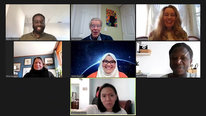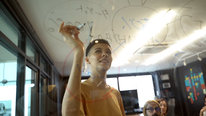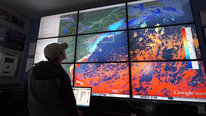- Marcia Gumpertz
- https://www4.stat.ncsu.edu/~gumpertz/
- Professor
- AGEP-NC Alliance:Institutional Change Model
- https://agep-nc.org/
- North Carolina State University
- Keith Schimmel
- https://www.ncat.edu/employee-bio.php?directoryID=779573323
- Director
- AGEP-NC Alliance:Institutional Change Model
- https://agep-nc.org/
- North Carolina A&T State University
AGEP-NC Alliance:Institutional Change Model
NSF Awards: 1820536, 1820538, 1820582
The AGEP-NC project, an Alliance of NC A&T State University, UNC Charlotte and NC State, provides a catalyst for departments wishing to build an infrastructure for their doctoral programs and a culture among dissertation advisors that successfully prepares underrepresented minority (URM) dissertation students for faculty careers in the sciences and engineering.
Our vision is to develop a corps of faculty fellows, deans, department heads and directors of graduate programs leading their departments in planning and implementing enhancements to doctoral programs to promote success for underrepresented minority dissertation students.
The AGEP-NC model is designed so that individual STEM departments can tailor the approach to their own departmental needs and culture.
AGEP-NC Alliance:Institutional Change Model
NSF Awards: 1820536, 1820538, 1820582
The AGEP-NC project, an Alliance of NC A&T State University, UNC Charlotte and NC State, provides a catalyst for departments wishing to build an infrastructure for their doctoral programs and a culture among dissertation advisors that successfully prepares underrepresented minority (URM) dissertation students for faculty careers in the sciences and engineering.
Our vision is to develop a corps of faculty fellows, deans, department heads and directors of graduate programs leading their departments in planning and implementing enhancements to doctoral programs to promote success for underrepresented minority dissertation students.
The AGEP-NC model is designed so that individual STEM departments can tailor the approach to their own departmental needs and culture.
-
 Meaningful Virtual Teaching Mentorships: Lessons from COVID
Meaningful Virtual Teaching Mentorships: Lessons from COVID
Erica LoBello
-
 Supporting Hispanics in the Time of COVID-19
Supporting Hispanics in the Time of COVID-19
Ann Gates
-
 Building Resilence Through Co-Production
Building Resilence Through Co-Production
Carrie Ferraro
-
 Interdisciplinary Community-Engaged Systems-Thinking Project
Interdisciplinary Community-Engaged Systems-Thinking Project
Heather Hopkins
-
 Discrimination in Engineering Graduate Education
Discrimination in Engineering Graduate Education
Matthew Bahnson
-
 NMSU Computer Science Virtual Summer Programs
NMSU Computer Science Virtual Summer Programs
Raena Cota
2791 Views
Continue the discussion of this presentation on the Multiplex. Go to Multiplex
2791 Views
presentation
has been viewed
Related videos you might be interested in...
-
 Meaningful Virtual Teaching Mentorships: Lessons from COVID
Meaningful Virtual Teaching Mentorships: Lessons from COVID
Erica LoBello
-
 Supporting Hispanics in the Time of COVID-19
Supporting Hispanics in the Time of COVID-19
Ann Gates
-
 Building Resilence Through Co-Production
Building Resilence Through Co-Production
Carrie Ferraro
-
 Interdisciplinary Community-Engaged Systems-Thinking Project
Interdisciplinary Community-Engaged Systems-Thinking Project
Heather Hopkins
-
 Discrimination in Engineering Graduate Education
Discrimination in Engineering Graduate Education
Matthew Bahnson
-
 NMSU Computer Science Virtual Summer Programs
NMSU Computer Science Virtual Summer Programs
Raena Cota


Marcia Gumpertz
Professor
Welcome to the North Carolina Alliance for Graduate Education and the Professoriate (AGEP-NC) video! We are an alliance of NC A&T State University, NC State University, and UNC Charlotte to implement and study a model for enhancing diversity and inclusion in STEM doctoral programs. We are midway through this 5-year NSF-funded project. Faculty fellows in 28 departments across the three institutions are working with their faculty colleagues to develop strategies to transform their doctoral programs so that they better promote the success of diverse students. We'd love to hear your questions about this approach, your strategies for building inclusive STEM doctoral programs, and your thoughts on whether this type of approach would work at your institution.
Best, Marcia Gumpertz, Professor of Statistics, NC State
Erin Krupa
Nuria Jaumot-Pascual
Research Scientist
It was great to hear about how AGEP NC Alliance is institutionalizing paying attention to diversity in the promotion and tenure process. Knowing how difficult it is to change systems, I wonder how faculty received these changes. I would also like to hear about what the project has seen as its major impacts in terms of changing how faculty work with graduate students.
Marcia Gumpertz
Professor
So far, two departments have incorporated diversity, equity and inclusion into their reappointment, promotion and tenure guidelines. The department heads have been actively involved in making the changes. In one of the departments, at least, the department culture is very open to diversity considerations. There's a video of the department head discussing department culture online at https://youtu.be/fT2m0lCaFWA (more videos at agep-nc.org). In other departments it's a much tougher sell to change the RPT guidelines. Some are incorporating diversity sections into their annual faculty activity reports, and I think that change is welcome. I don't have results yet on changes in how faculty work with graduate students. Several of our faculty fellows and a few faculty in their departments have undergone training in inclusive mentoring. Many departments feel that their faculty are already doing a good job of mentoring and are not as interested in mentor training...
Nuria Jaumot-Pascual
Stephen Alkins
Diversity, Equity, and Inclusion Officer
Great presentation! I especially valued the intentional creation of the peer mentoring group, which may happen informally, but usually dissolves once students are in laboratories. It ensures that students have someone to support them that may be outside of their laboratory, which is beneficial.
This was going to be my question: how has mentoring, and particularly mentoring of underrepresented students, been prioritized in the RPT process? Inclusive and culturally responsive mentor training seems like it should be mandatory, but there is a fear that it may sow seeds further steeped in bias and often is met with "we are already doing a good job" as you say. Could you provide a bit more detail into how departments are developing Diversity, Equity, Inclusion, and Belonging sections in their reports? How do those departments who don't do it reporting their progress?
Marcia Gumpertz
Professor
Hi Stephen,
Thanks for your comments and questions! Here's the new Faculty Activity Report language from one department:
"DIVERSITY ACTIVITIES:
Please describe activities related to diversity, equity and inclusion at either the personal (off campus), department, college, or university level, or in the discipline."
Previously there was nowhere to report these activities, so you had to creatively incorporate them into the sections on service, teaching, mentoring and research.
One department added the following statements to their RPT guidelines under Teaching Performance Standards: "All faculty are expected to create and maintain an inclusive learning environment". Under Research Performance Standards they added "Attracting graduate students into a specific research program, success of graduate students and other trainees, and establishment of an inclusive training culture are indications of the stature of an individual's research program." They are currently working on rubrics to evaluate these efforts and accomplishments.
Nuria Jaumot-Pascual
Overtoun Jenda
Assistant Provost and Professor of Mathematics
This is a very good model. Do you have plans for dissemination for other departments to replicate? Did you survey the students of students and faculty to measure the effectiveness of the program? How many students and departments are currently participating? Great work!
Marcia Gumpertz
Professor
Dear Dr. Jenda, Thanks so much for your comments and questions. We are planning to start offering workshops this fall for campuses interested in adapting and implementing this model at their own institution. I'd be very happy to talk with anyone who is interested in having us come to do a workshop. Please just contact me.
We do survey the doctoral students and faculty in the participating departments about the climate and about department practices. These surveys are done at the beginning of the faculty fellow's two year term and in the semester after the two-year term is over. Our project includes a study of mentoring practices and attitudes and the experiences of students with the mentoring that they have had, so we also do surveys, focus groups and interviews on mentoring specifically. All of the survey instruments are available online at https://agep-nc.org/index.php/toolkit/ toward the bottom of the page. Currently, 28 departments are participating across the three institutions. We don't work directly with any students, except to survey and interview them.
Rani Sullivan
Hello Marcia,
This is a great framework for promoting inclusivity. Incentivizing faculty to include diversity distributes the workload and goes a long way in addressing current diversity issues. Is there a publication that gives more information about this model?
Keith Schimmel
Director
Hi Rani - A couple of publications on the AGEP-NC model are available at https://agep-nc.org/index.php/agep-nc-alliance/...
Connie Mayberry
Daniel Serrano
Wow! Thanks for sharing your great project. I appreciate the team's effort to put together a comprehensive program to address system-level and cultural barriers within the academic environment.
I was wondering if you foresaw or have encountered any hurdles when implementing a program like this within units where not all faculty might be open to these approaches (possibly resistant to change, or resistant to reallocating time and energy to non-research activities).
Keith Schimmel
Director
Thanks for asking this important question. We seek to maximize faculty buy-in through strategies such as:
1) Demonstrating with data the project collects from our students and faculty the need for change and successes that have come from changes.
2) Working with departmental leadership - chair, graduate program coordinator, AGEP faculty fellow - to build consensus for changes that are tailored to the unique environment of each department.
As we collect more data from students and faculty, we will get a better idea of how successful these strategies have been.
Marcia Gumpertz
Professor
Hi Daniel, There will definitely be different levels of interest and openness, both within and between departments. We ask that when faculty apply to be AGEP-NC Fellows, that their department head and the director of their graduate programs both provide letters of support in which they commit to working with the faculty fellow, providing them release from other service obligations, and promoting the Fellow's initiatives within the department. We also meet with the department head and graduate director once or twice each year to go over what to expect from the program, what their roles are and what surveys and actions are needed in the upcoming semester. This helps by both ensuring that the department leadership is on board before the Fellow starts and by forming a trio of three faculty promoting these discussions and changes.
Daniel Serrano
Thanks for the insight, Keith and Marcia!
Ann Gates
Great video! Can you describe any training or guidance that is provided to peer mentors?
Keith Schimmel
Director
Some of our project faculty are trained as CIMER facilitators and much of our mentor training utilizes CIMER materials - see https://cimerproject.org/ .
Nuria Jaumot-Pascual
Research Scientist
I wonder about the push for faculty careers for doctoral students, how they receive it, and the project's motivation to push for these. I imagine that one of the main motivators is to promote diversity among faculty so that younger students see themselves represented in their professors. Are there other reasons to push for academic careers?
The reason I ask this is because when I was in my PhD program just a few years ago, that was something that the faculty did and that I did not appreciate for two main reasons: (1) there are many careers out there for PhD holders that can be impactful in society and utilize the skills learned in the doctoral program (I was already working in my current job, so it felt as if it was looked down at), and (2) currently, the reality of academia is that tenure-track positions are harder and harder to come by.
Keith Schimmel
Director
Hi Nuria - Thanks for asking this important question.
The NSF AGEP program that has provided our project funding is specifically focused on increasing the number of minority STEM PhD students that go on to successful faculty careers. So, this is what our focus has been.
However, you are certainly correct that more PhD graduates go into jobs outside of academia, and our students are not well served if this is ignored. We believe that the emphasis in the project on developing strong mentor-mentee relationships and a network of mentors will provide students opportunities to have rich discussions on the contrast between academic positions and other career tracks.
Some of the best teachers I have had were ones who spent time in industry and then moved into academic positions. So, even if our students go directly into industry or government after graduating with the PhD, we want them to be knowledgeable about how to be prepared to compete successfully for academic positions, if they later choose to move in this direction.
Marcia Gumpertz
Professor
Hi Ann, Thanks for watching our video! The department that was represented in the video that is developing a peer mentoring program for their graduate students will be working with NC State's Graduate Peer Mentoring Collaborative (https://grad.ncsu.edu/students/peer-mentoring/). This program is sponsored by NC State's Graduate School. The goals of the program are to learn about and form quality mentoring relationships. They provide workshops and their faculty advisors provide consultations for departmental peer mentoring programs. In the peer mentoring program, the senior students who will be participating as mentors will be provided readings on how to be an effective mentor, potential topics that could be discussed between peers, and will meet with a group of three faculty, including the Department Head, to discuss best mentoring practices.